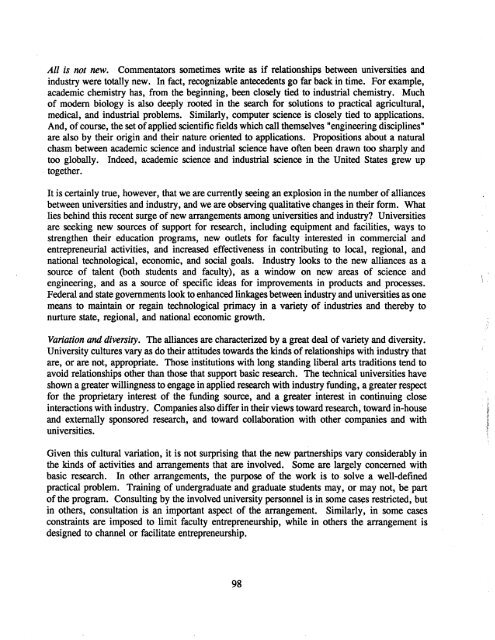WHOI-90-52
WHOI-90-52
WHOI-90-52
Create successful ePaper yourself
Turn your PDF publications into a flip-book with our unique Google optimized e-Paper software.
All is not new. Commentators sometimes write as if relationships between universities and<br />
industry were totaly new. In fact, recgnizable anteents go far back in time. For example,<br />
academic chemistry has, from the beginning, been closely tied to industral chemistr. Much<br />
of modern biology is also deeply rooted in the sech for solutions to practica agricultura,<br />
medica, and industral problems. Similarly, computer science is closely tied to applications.<br />
And, of course, the set of applied scientific fields which cal themselves "engineering disciplines"<br />
are also by their origin and their nature oriente to applications. Propositions about a natura<br />
chasm between academic science and industral science have often been drawn too sharly and<br />
too globally. Indee, academic science and industral science in the Unite States grew up<br />
together.<br />
It is certnly tre, however, that we are currently seing an explosion in the number of alliances<br />
between universities and industry, and we are observing qualitative changes in their form. What<br />
lies behind this recnt surge of new arangements among universities and industr? Universities<br />
are seking new sources of support for resech, including equipment and facilties, ways to<br />
strengthen their education programs, new outlets for faculty interested in commercial and<br />
entrepreneurial activities, and increase effectiveness in contrbuting to loc, regional, and<br />
national technologica, ecnomic, and social goals. Industr looks to the new alliances as a<br />
source of taent (both students and faculty), as a window on new areas of science and<br />
engineering, and as a source of speific ideas for improvements in products and procsses.<br />
Federa and state governments look to enhance linkages between industr and universities as one<br />
meas to maintan or regain technologica primacy in a varety of industres and thereby to<br />
nurtre state, regional, and national ecnomic growth.<br />
Variaton and diversity. The alliances are characterize by a great dea of varety and diversity.<br />
University cultures var as do their attitudes towards the kinds of relationships with industr that<br />
are, or are not, appropriate. Those institutions with long stading liberal ars traditions tend to<br />
avoid relationships other than those that support basic resech. The technica universities have<br />
shown a greater wilingness to engage in applied resech with industr funding, a greater respet<br />
for the proprieta interest of the funding source, and a greater interest in continuing close<br />
interactions with industr. Companies also differ in their views toward resech, toward in-house<br />
and externaly sponsored resech, and toward collaboration with other companies and with<br />
universities.<br />
Given ths cultural varation, it is not surprising that the new parerships var considerably in<br />
the kinds of activities and arangements that are involved. Some are largely concerned with<br />
basic resech. In other arangements, the purpse of the work is to solve a well-defined<br />
practica problem. Training of undergraduate and graduate students may, or may not, be par<br />
of the program. Consulting by the involved university personnel is in some caStS restrcte, but<br />
in others, consultation is an importt aspet of the argement. Similarly, in some cases<br />
constrnts are impose to limit faculty entrepreneurship, while in others the argement is<br />
designed to channel or faciltate entrepreneurship.<br />
98<br />
i<br />
\ .
















